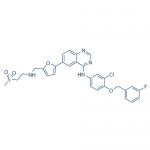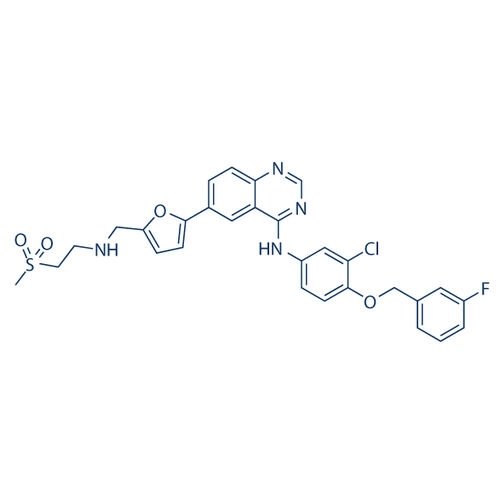| Product Name | Lapatinib |
| Description |
Dual EGFR/HER2 Tyrosine Kinase Inhibitor |
| Purity | >99% |
| CAS No. | 231277-92-2 |
| Molecular Formula | C29H26ClFN4O4S |
| Molecular Weight | 581.1 |
| Field of Use | Not for use in humans. Not for use in diagnostics or therapeutics. For in vitro research use only. |
Properties
| Storage Temperature | -20ºC |
| Shipping Temperature | Shipped Ambient |
| Product Type | Inhibitor |
| Solubility | Solubility in water is 0.007 mg/ml and in 0.1N HCl is 0.001 mg/ml at 25° C |
| Source | Synthetic |
| Appearance | Yellow crystalline solid |
| SMILES | C2=C1C(=NC=NC1=CC=C2C3=CC=C(O3)CNCC[S](=O)(=O)C)NC4=CC=C(C(=C4)Cl)OCC5=CC=CC(=C5)F |
| InChI | InChI=1S/C29H26ClFN4O4S/c1-40(36,37)12-11-32-16-23-7-10-27(39-23)20-5-8-26-24(14-20)29(34-18-33-26)35-22-6-9-28(25(30)15-22)38-17-19-3-2-4-21(31)13-19/h2-10,13-15,18,32H,11-12,16-17H2,1H3,(H,33,34,35 |
| InChIKey | BCFGMOOMADDAQU-UHFFFAOYSA-N |
| Safety Phrases |
Classification: Not a hazardous substance or mixture. Safety Phrases: S22 - Do not breathe dust. S24/25 - Avoid contact with skin and eyes. S36/37/39 - Wear suitable protective clothing, gloves and eye/face protection. |
| Cite This Product | Lapatinib (StressMarq Biosciences Inc., Victoria BC CANADA, Catalog # SIH-459) |
Biological Description
| Alternative Names | N-[3-chloro-4-[(3-fluorophenyl)methoxy]phenyl]-6-[5-[(2-methylsulfonylethylamino)methyl]furan-2-yl]quinazolin-4-amine |
| Research Areas | Apoptosis, Cancer, Cancer Growth Inhibitors, Cell Signaling, Growth Factor Receptor Inhibitors |
| PubChem ID | 208908 |
| Scientific Background | Lapatinib is a dual tyrosine kinase inhibitor that targets the ErbB2 (HER2) and epidermal growth factor receptor (EGFR) pathways. While primarily used in oncology, Lapatinib has potential applications in neuroscience due to the involvement of EGFR signaling in neuroinflammation, gliosis, and neurodegeneration. It is being explored for its ability to modulate glial cell activity and protect against excitotoxicity in models of Alzheimer's disease and brain injury. Lapatinib’s ability to cross the blood-brain barrier enhances its utility in central nervous system research. |
| References |
1. Chien A.J., et al. (2014) J. Clin. Oncol: J. Am. Clin. Oncol. 32(14): 1472–1479. 2. Dahal B.K., et al. (2010) Am. J. Resp. Critical Care Med. 181(2): 158–167. |



Reviews
There are no reviews yet.